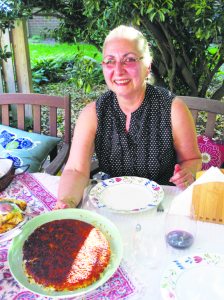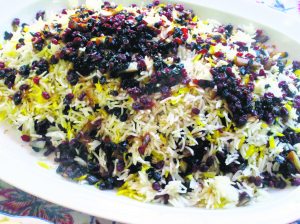Thanks to Yelena Craanen, I now have the perfect recipe for when my garden gets overrun with herbs. It is ghormeh sabzi, a Persian herb stew that is said to be Iran’s national dish and is packed with parsley, chives, coriander and fenugreek.
When Yelena, who is generally known as Ella, and I first discussed what cuisine she would cook for me, a few choices were possible. How about Dutch, the food of August, her husband of 40 years who was from Amsterdam? No, that was not really her cuisine even though she learned how to cook authentic Dutch dishes from her mother-in-law. She could have chosen Armenian, her ethnicity, but she felt that she would be more comfortable demonstrating Persian, the food of Iran, where she grew up. “Many of the Armenian dishes I cook are variations in the flavor of Persian food,” she said. “Armenians, not unlike any other ethnic groups living in various regions, have adapted to the region’s food.”

“I am more of a Persian than Armenian,” she said, although ethnically she is pure Armenian. Her family has been touched by epic and tragic times in world history—a grandfather was a survivor of the Armenian genocide when the Ottoman government systematically exterminated its minority Armenian population, beginning in 1915. Her parents, who had settled in Ukraine, came to Iran after WWII when the communists came into power. She and August barely escaped Iran at the time of the Islamic revolution in 1979.
Thirty years ago, when August was transferred from his job as an engineer at the Four Seasons Hotel in Toronto, the couple settled in Westbury, where they have been ever since. August is retired but Ella is a business relations coordinator working at ACCES-VR, part of the state Education Department.
Ella and August have created a garden oasis in their backyard where wisteria hangs overhead from a trellis and a table on a patio welcomes guests to enjoy her culinary skills.
A must at a Persian dinner party is the aforementioned ghormeh sabzi, which translates as “stewed greens.” In addition to herbs, Ella’s recipe calls for lamb shank, kidney beans and Persian lime (the lime most typically found in grocery stores), slow cooked so that the lamb and beans are fork tender.

Rice is an important part of the cuisine and a favorite of Iranians, and now me, is tadeeg—“bottom of the pot”—referring to the crispy bottom layer. Long-grain, white basmati rice is washed several times to get out any extra starch, soaked for nearly half a day, drained and then parboiled. This rice is ultimately placed atop a mixture of hot oil and butter to create the crisp. There’s a lot more to it—many Persian dishes are labor-intensive, although simple lunches of cheese, quince or cherry jam and flat breads are also favored, as well as grilled meats.
The beauty-queen of the table was the platter of zereshk polow—rice with red barberries. Saffron colored and white rice are mixed together and garnished with tiny barberries that grow on deciduous shrubs in cluster like grapes. The barberries added an appealing tartness to the dish. Known as “celebration rice” or “jeweled rice,” this is often cooked for weddings.
Typically a Persian meal ends with fruit. Ella recalled her grandmother’s trellis that was filled with grapes of many varieties. If there were baked sweets, she says, they would come from a shop. “No one makes them at home,” she said.





























